Analysis of the Effect of Ventilation Bars on the Packing Structure of Sinter Bed by DEM Simulation
Abstract
1. Introduction
2. Simulation Methods and Determination of Simulation Parameters
2.1. Discrete Element Method (DEM)
2.2. Determination of Simulation Parameters
2.3. Experiment Results of Angle of Repose
2.4. Simulation of the Test of Angle of Repose
3. Results
Analysis of the Effect of Ventilation Bars on the Packing Structure
4. Discussion
5. Conclusions
Author Contributions
Funding
Acknowledgments
Conflicts of Interest
References
- Kasama, S.; Inazumi, T.; Nakayasu, T. New Analysis Method of Sinter Cake Pore Structure for Permeability Evaluation. ISIJ Int. 1994, 34, 562–569. [Google Scholar] [CrossRef]
- Higuchi, K.; Kawaguchi, T.; Kobayashi, M.; Hosotani, Y.; Nakamura, K.; Iwamoto, K.; Fujimoto, M. Improvement of productivity by stand-support sintering in commercial sintering machines. ISIJ Int. 2000, 40, 1188–1194. [Google Scholar] [CrossRef]
- Iwami, Y.; Yamamoto, T.; Oyama, N.; Matsuno, H.; Saito, N.; Nakashima, K. Improvement of Sinter Productivity by Control of Magnetite Ore Segregation in Sintering Bed. ISIJ Int. 2018, 58, 2200–2209. [Google Scholar] [CrossRef]
- Ichikawa, K.; Ishii, J.; Watakabe, S.; Sato, M. Quantitative Estimation of Gas Permeability of Softening Sinter Layer with Liquid Phase. ISIJ Int. 2015, 55, 544–551. [Google Scholar] [CrossRef][Green Version]
- Ngo, I.L.; Byon, C. Permeability of microporous wicks with geometric inverse to sintered particles. Int. J. Heat Mass Transf. 2016, 92, 298–302. [Google Scholar] [CrossRef]
- Nyembwe, A.M.; Cromarty, R.D.; Garbers-Craig, A.M. Relationship Between Iron Ore Granulation Mechanisms, Granule Shapes, and Sinter Bed Permeability. Miner. Process. Extr. Metall. Rev. 2017, 38, 388–402. [Google Scholar] [CrossRef]
- Li, C.Z.; Honeyands, T.; O’Dea, D.; Moreno-Atanasio, R. The angle of repose and size segregation of iron ore granules: DEM analysis and experimental investigation. Powder Technol. 2017, 320, 257–272. [Google Scholar] [CrossRef]
- Li, C.Z.; Honeyands, T.; O’Dea, D.; Moreno-Atanasio, R. DEM study on size segregation and voidage distribution in green bed formed on iron ore sinter strand. Powder Technol. 2019, 356, 778–789. [Google Scholar] [CrossRef]
- Fukami, K.; Itaya, H.; Aratani, F.; Nakanishi, K.; Nishimura, H. A Study on the Particle-Size Segregation in the Sintering Bed Formed at the Feeding Stage of A Sinter Machine. Tetsu Hagane 1985, 71, 1888–1894. [Google Scholar] [CrossRef]
- Cundall, P.A.; Strack, O.D.L. Discrete Numerical-Model for Granular Assemblies. Geotechnique 1979, 29, 47–65. [Google Scholar] [CrossRef]
- Chen, H.; Wei, Q.S.; Wen, S.F.; Li, Z.W.; Shi, Y.S. Flow behavior of powder particles in layering process of selective laser melting: Numerical modeling and experimental verification based on discrete element method. Int. J. Mach. Tools Manuf. 2017, 123, 146–159. [Google Scholar] [CrossRef]
- Chen, H.; Chen, Y.X.; Liu, Y.; Wei, Q.S.; Shi, Y.S.; Yan, W.T. Packing quality of powder layer during counter-rolling-type powder spreading process in additive manufacturing. Int. J. Mach. Tools Manuf. 2020, 153. [Google Scholar] [CrossRef]
- Chen, H.; Wei, Q.S.; Zhang, Y.J.; Chen, F.; Shi, Y.S.; Yan, W.T. Powder-spreading mechanisms in powder-bed-based additive manufacturing: Experiments and computational modeling. Acta Mater. 2019, 179, 158–171. [Google Scholar] [CrossRef]
- Ishihara, S.; Kano, J. ADEM Simulation for Analysis of Particle Breakage of Irregular Shaped Particles. ISIJ Int. 2019, 59, 820–827. [Google Scholar] [CrossRef]
- Natsui, S.; Ishihara, S.; Kon, T.; Ohno, K.; Nogami, H. Detailed modelling of packed-bed gas clogging due to thermal-softening of iron ore by Eulerian-Lagrangian approach. Chem. Eng. J. 2020, 392. [Google Scholar] [CrossRef]
- Ishihara, S.; Kano, J. Development of ADEM-SPH coupling model for analysis of solid to liquid phase transition behaviors. ISIJ Int. 2020, 60, 1469–1478. [Google Scholar] [CrossRef]
- Kon, T.; Natsui, S.; Ueda, S.; Nogami, H. Analysis of Effect of Packed Bed Structure on Liquid Flow in Packed Bed Using Moving Particle Semi-implicit Method. ISIJ Int. 2015, 55, 1284–1290. [Google Scholar] [CrossRef]
- Kurosawa, H.; Matsuhashi, S.; Natsui, S.; Kon, T.; Ueda, S.; Inoue, R.; Ariyama, T. DEM-CFD Model Considering Softening Behavior of Ore Particles in Cohesive Zone and Gas Flow Analysis at Low Coke Rate in Blast Furnace. ISIJ Int. 2012, 52, 1010–1017. [Google Scholar] [CrossRef]
- Natsui, S.; Ohno, K.; Sukenaga, S.; Kikuchi, T.; Suzuki, R.O. Detailed Modeling of Melt Dripping in Coke Bed by DEM—SPH. ISIJ Int. 2018, 58, 282–291. [Google Scholar] [CrossRef]
- Natsui, S.; Ueda, S.; Nogami, H.; Kano, J.; Inoue, R.; Ariyama, T. Penetration Effect of Injected Gas at Shaft Gas Injection in Blast Furnace Analyzed by Hybrid Model of DEM-CFD. ISIJ Int. 2011, 51, 1410–1417. [Google Scholar] [CrossRef]
- Natsui, S.; Ueda, S.; Fan, Z.Y.; Kano, J.; Inoue, R.; Ariyama, T. Sensitivity Analysis of Physical Parameters in Discrete Element Method Compared with Blast Furnace Cold Model Experiments. Tetsu Hagane 2010, 96, 1–10. [Google Scholar] [CrossRef][Green Version]
- Natsui, S.; Nogami, H.; Ueda, S.; Kano, J.; Inoue, R.; Ariyama, T. Simultaneous Three-dimensional Analysis of Gas-Solid Flow in Blast Furnace by Combining Discrete Element Method and Computational Fluid Dynamics. ISIJ Int. 2011, 51, 41–50. [Google Scholar] [CrossRef]
- Nakano, M.; Abe, T.; Kano, J.; Kunitomo, K. DEM Analysis on Size Segregation in Feed Bed of Sintering Machine. ISIJ Int. 2012, 52, 1559–1564. [Google Scholar] [CrossRef]
- Honorato, E.P.; Seshadri, V. Granulometric optimisation of raw materials for ISF continuous segregation system in Usiminas’ sintering plants. Ironmak. Steelmak. 2008, 35, 405–415. [Google Scholar] [CrossRef]
- Oyama, N.; Igawa, K.; Nushiro, K.; Ida, M.; Fujii, N. Effects of the magnetic field exerted on the plate type feeder on the void fraction in the sintering bed and sinter productivity. Tetsu Hagane 2000, 86, 309–314. [Google Scholar] [CrossRef]
- Nushiro, K.; Konishi, Y.; Igawa, K.; Takihira, K.; Fujii, N. Formation of the vertical slits in the lower part of a sintering bed and their effect on sintering. Tetsu Hagane 1997, 83, 413–418. [Google Scholar] [CrossRef][Green Version]
- Ishihara, S.; Soda, R.; Zhang, Q.W.; Kano, J. DEM Simulation of Collapse Phenomena of Packed Bed of Raw Materials for Iron Ore Sinter during Charging. ISIJ Int. 2013, 53, 1555–1560. [Google Scholar] [CrossRef][Green Version]
- Zhu, H.P.; Zhou, Z.Y.; Yang, R.Y.; Yu, A.B. Discrete particle simulation of particulate systems: A review of major applications and findings. Chem. Eng. Sci. 2008, 63, 5728–5770. [Google Scholar] [CrossRef]
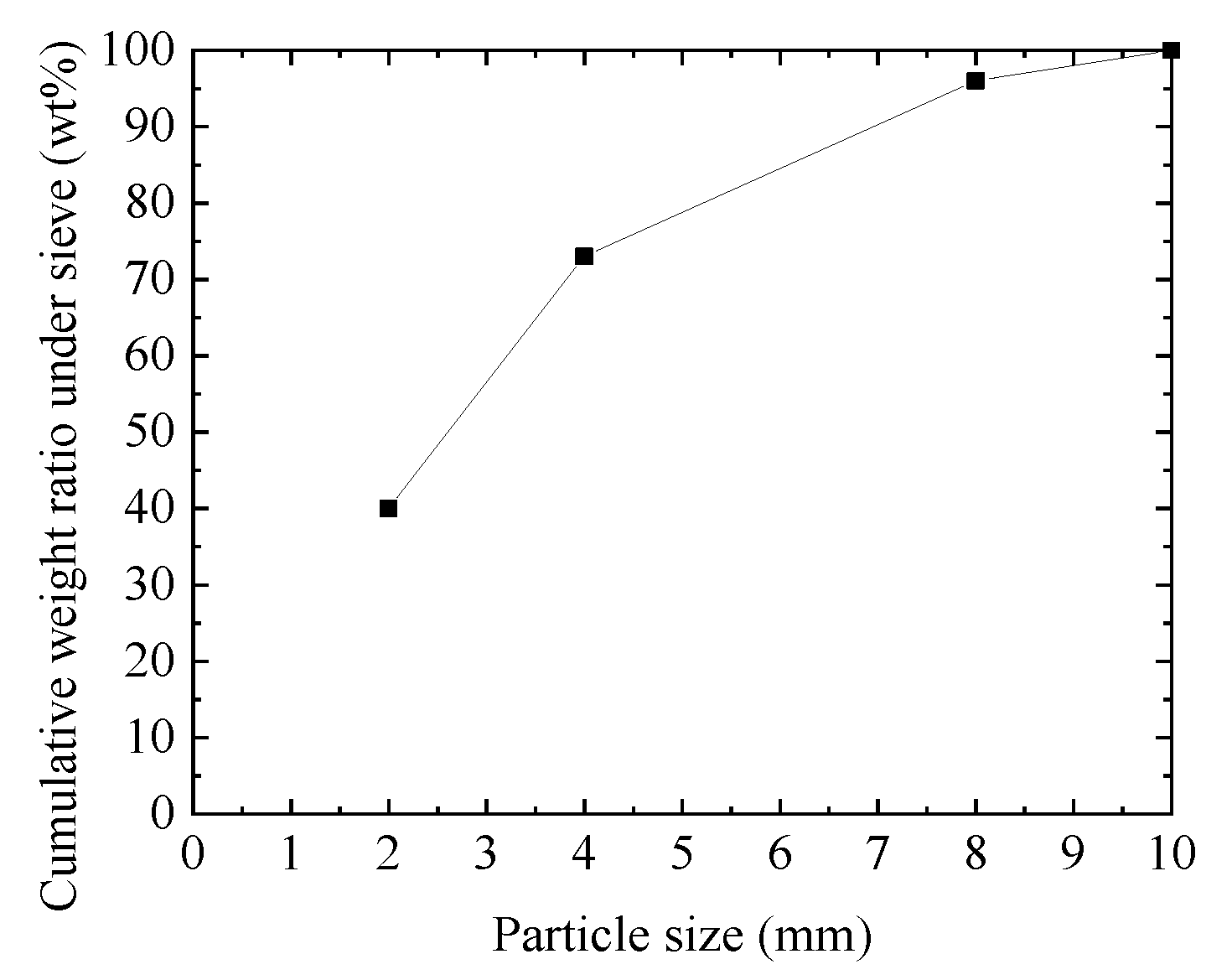
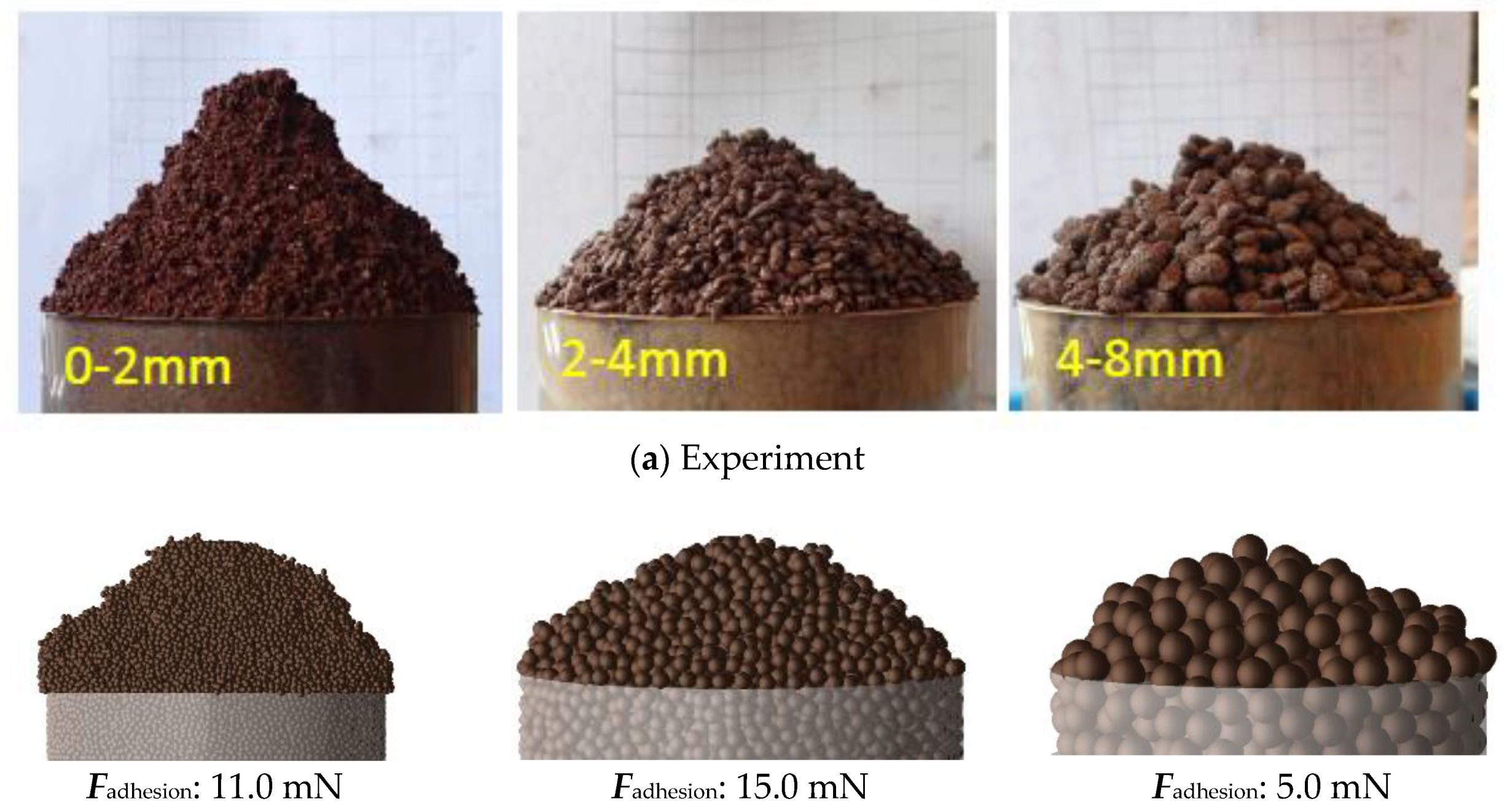

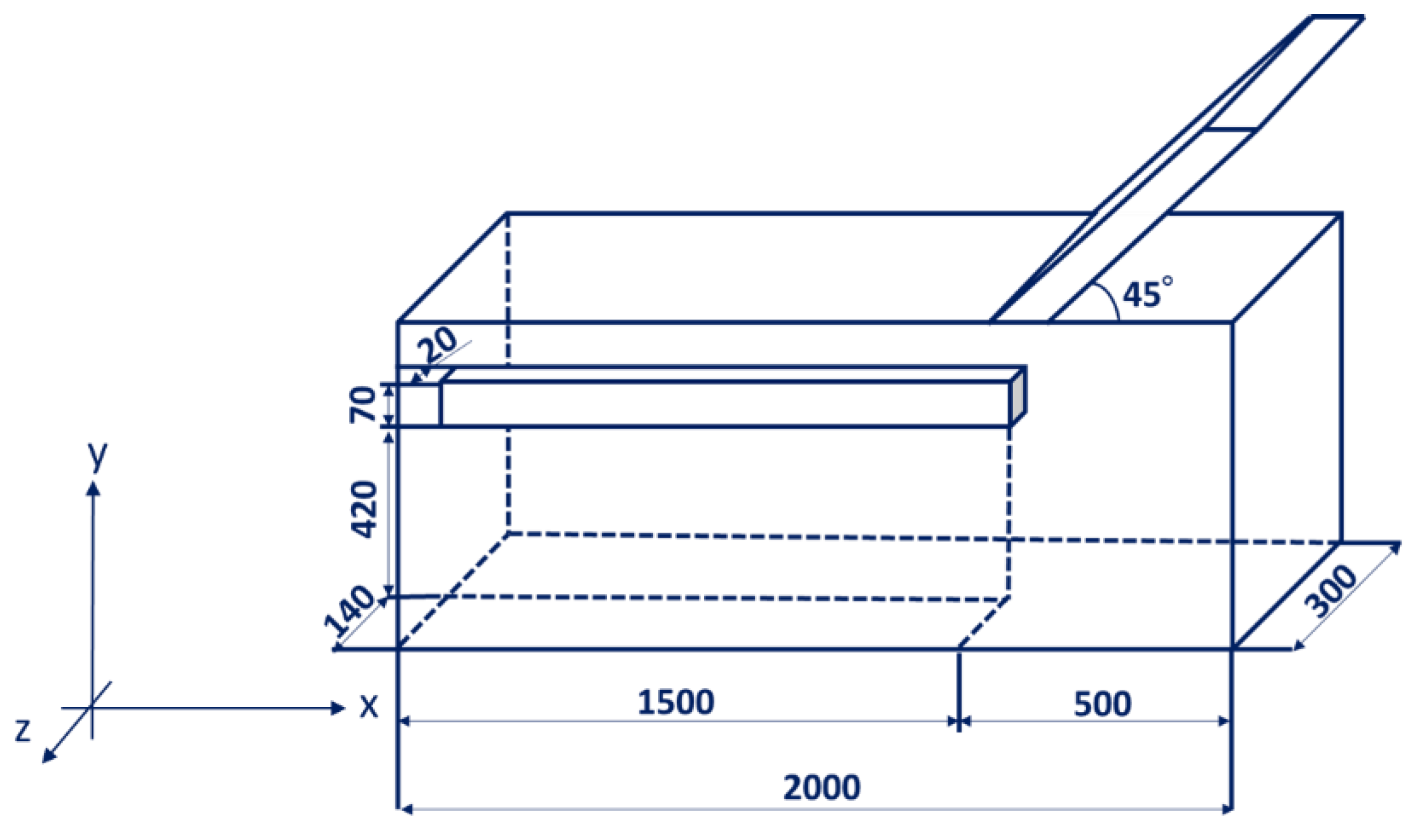


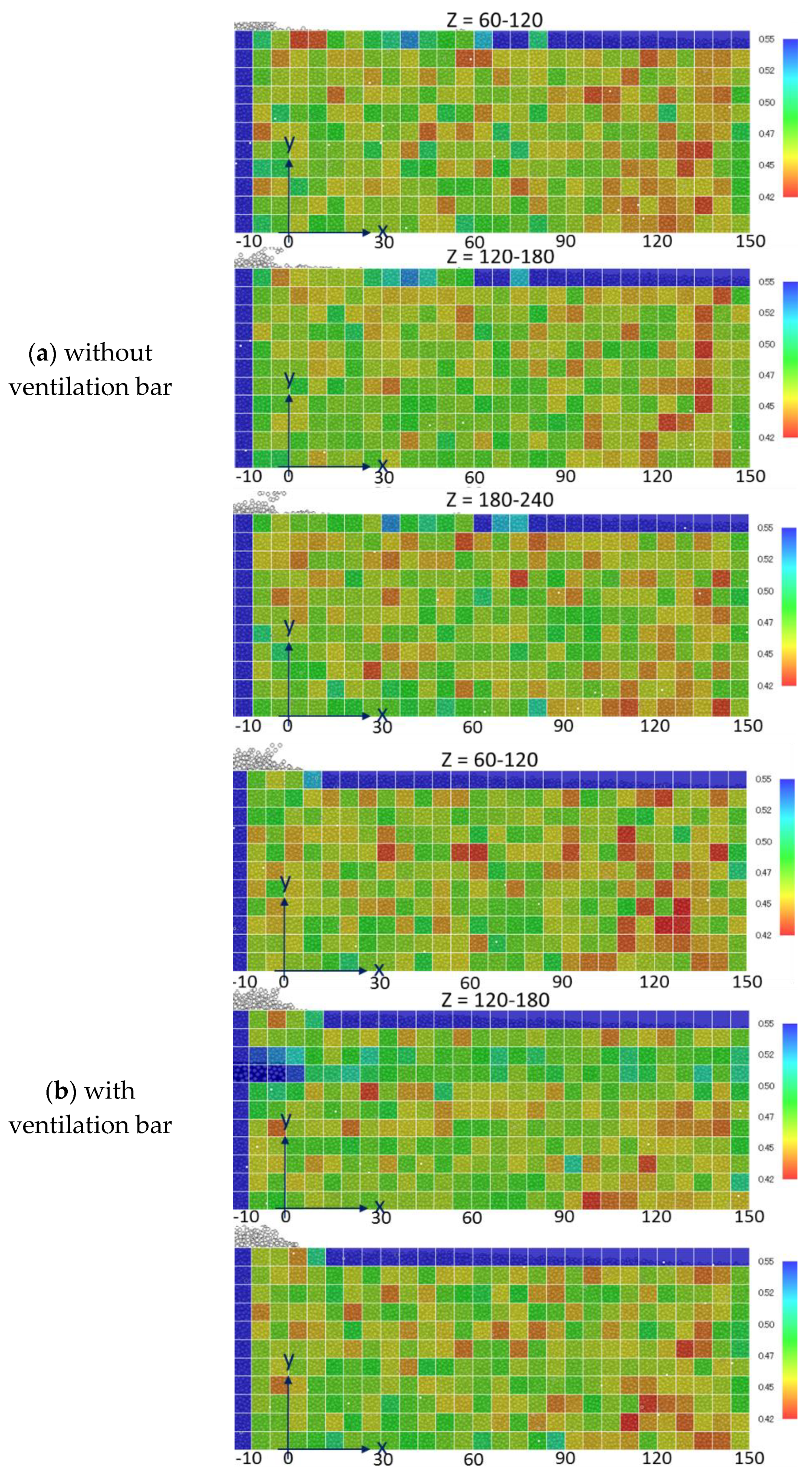


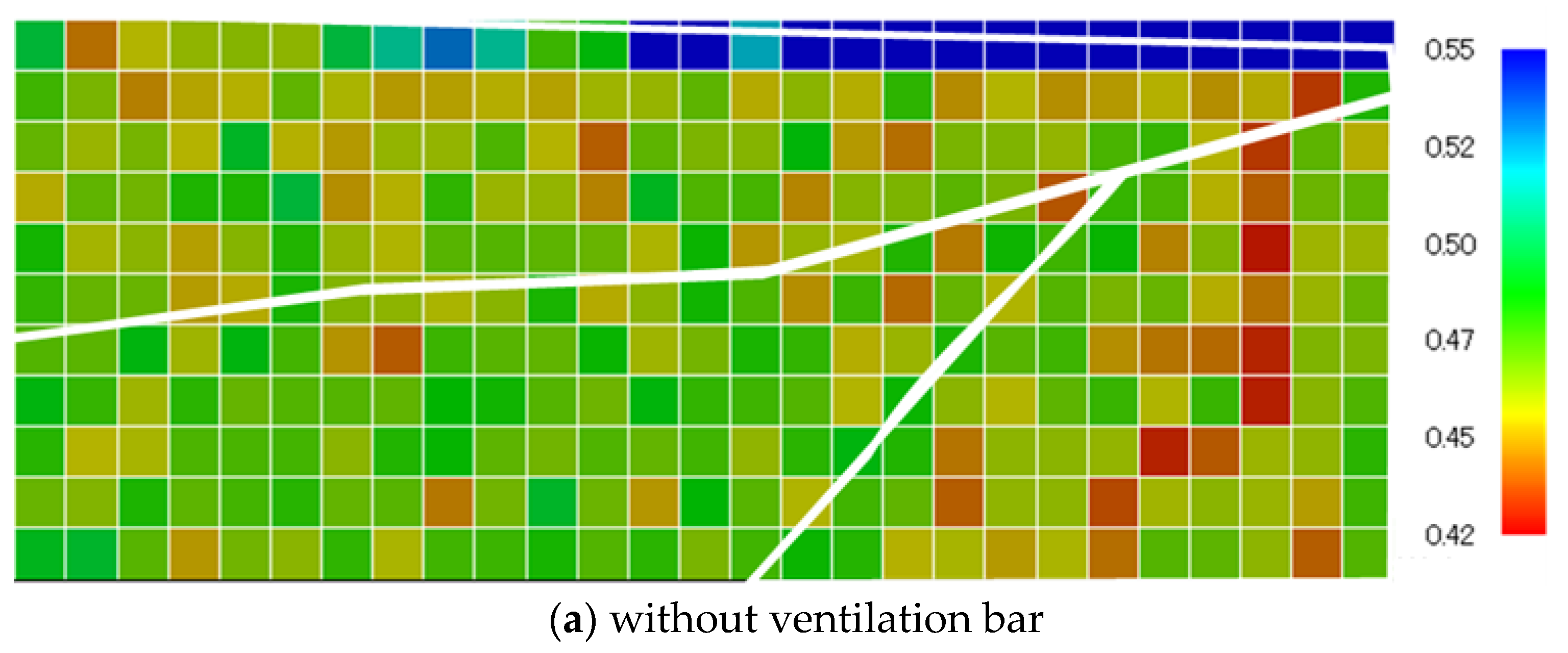

| Particle Size | Angle of Repose | ||
|---|---|---|---|
| n = 1 | n = 2 | Average | |
| 0–2 | 48.3 | 48.5 | 48.4 |
| 2–4 | 36.5 | 36.5 | 36.5 |
| 4–8 | 35.9 | 32.5 | 34.2 |
| Parameters | Unit | Value |
|---|---|---|
| Particle diameter | mm | 2, 4, 8 |
| Friction coefficient | - | 0.65 |
| Rolling friction coefficient | - | 4.0 |
| Density | kg/m3 | 2500 |
| Adhesion force | mN | 0–15 |
© 2020 by the authors. Licensee MDPI, Basel, Switzerland. This article is an open access article distributed under the terms and conditions of the Creative Commons Attribution (CC BY) license (http://creativecommons.org/licenses/by/4.0/).
Share and Cite
Ishihara, S.; Kushimoto, K.; Kano, J. Analysis of the Effect of Ventilation Bars on the Packing Structure of Sinter Bed by DEM Simulation. Energies 2020, 13, 3836. https://doi.org/10.3390/en13153836
Ishihara S, Kushimoto K, Kano J. Analysis of the Effect of Ventilation Bars on the Packing Structure of Sinter Bed by DEM Simulation. Energies. 2020; 13(15):3836. https://doi.org/10.3390/en13153836
Chicago/Turabian StyleIshihara, Shingo, Kizuku Kushimoto, and Junya Kano. 2020. "Analysis of the Effect of Ventilation Bars on the Packing Structure of Sinter Bed by DEM Simulation" Energies 13, no. 15: 3836. https://doi.org/10.3390/en13153836
APA StyleIshihara, S., Kushimoto, K., & Kano, J. (2020). Analysis of the Effect of Ventilation Bars on the Packing Structure of Sinter Bed by DEM Simulation. Energies, 13(15), 3836. https://doi.org/10.3390/en13153836




